B-树(B-Tree)与二叉搜索树(BST):讲讲数据库和文件系统背后的原理(读写比较大块数据的存储系统数据结构与算法原理)...
Posted 禅与计算机程序设计艺术
tags:
篇首语:本文由小常识网(cha138.com)小编为大家整理,主要介绍了B-树(B-Tree)与二叉搜索树(BST):讲讲数据库和文件系统背后的原理(读写比较大块数据的存储系统数据结构与算法原理)...相关的知识,希望对你有一定的参考价值。
人类总喜欢发明创造一些新名词(比如说,简写/缩写/简称什么的),并通过这些名词把人群分成了三六九等。弄到最后,把自己都绕晕了。
你看,首先就是,B树,不要与Binary tree或B+tree混淆。
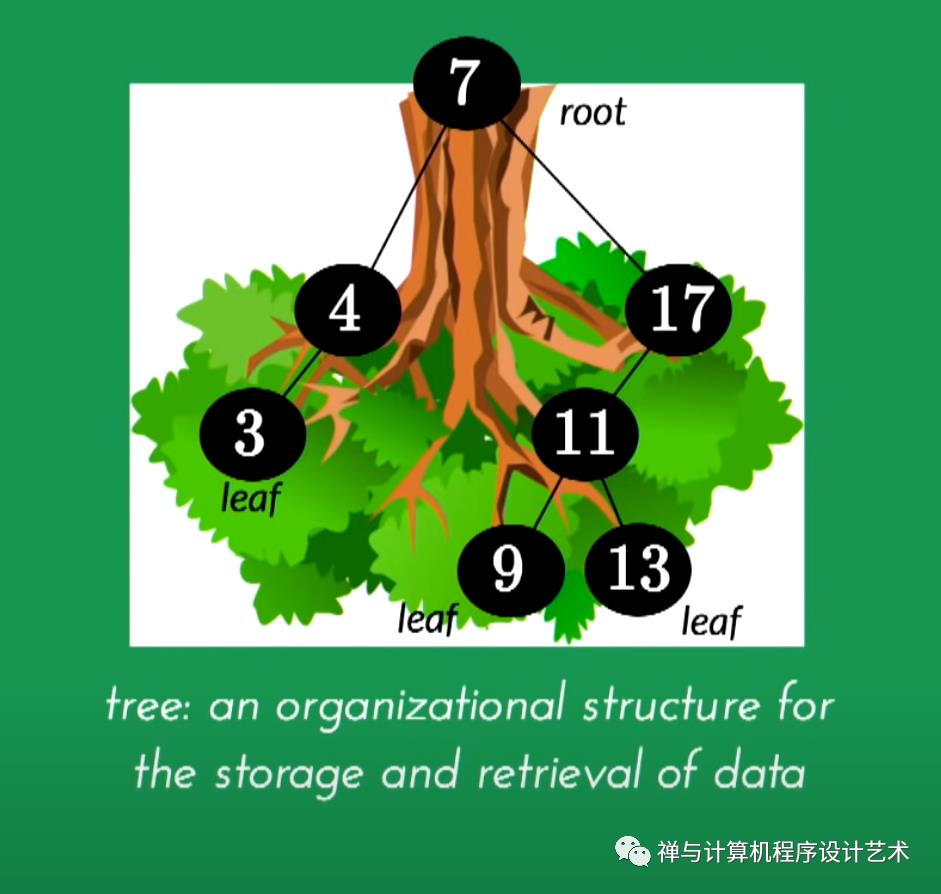
B 树定义
B树是一种的平衡多路查找树,我们把树中结点最大的孩子数目称为B树的阶,通常记为m。
一棵m阶B树或为空树,或为满足如下特征的m叉树:
1)树中每个结点至多有m棵子树。(即至多含有m-1个关键字)(“两棵子树指针夹着一个关键字”)。
2)若根结点不是终端结点(最底层非叶子结点),则至少含有两棵子树。
3)除根结点外的所有非叶子结点至少含有 ceil(m/2) 棵子树。(即至少含有ceil(m/2)-1个关键字)。
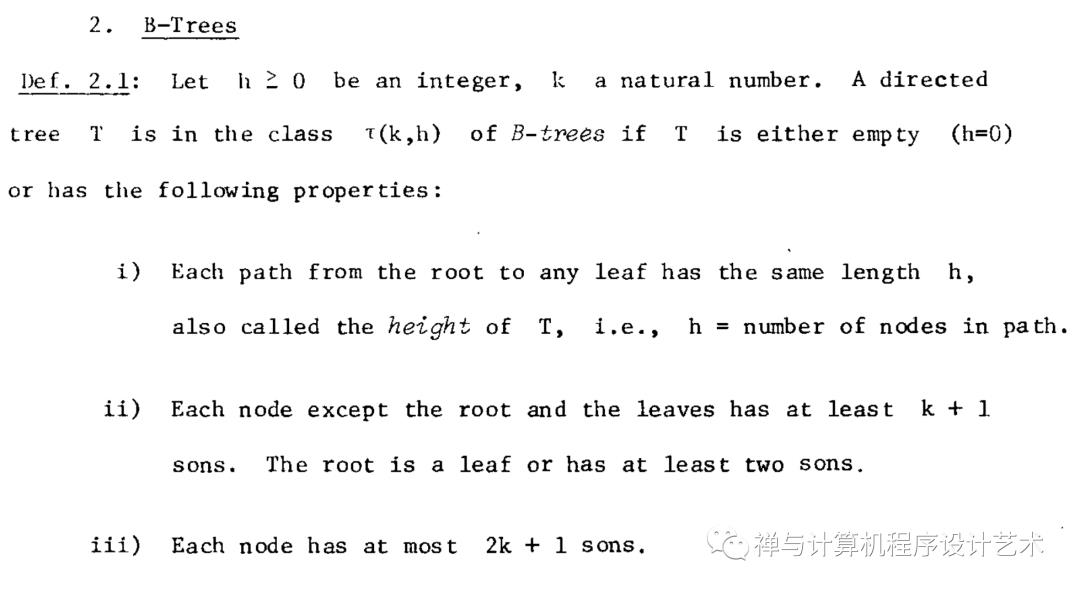
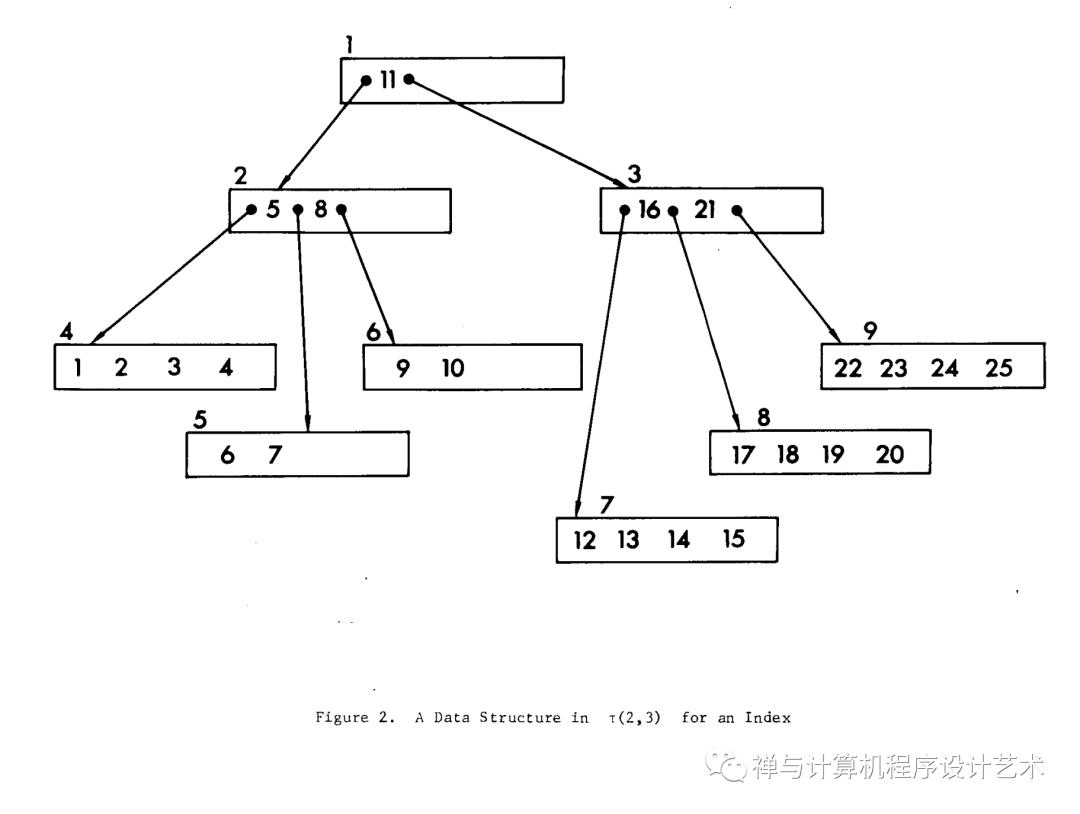 在计算机科学中,B 树是一种自平衡树数据结构,它维护已排序的数据并允许在对数时间内进行搜索、顺序访问、插入和删除。B 树推广了二叉搜索树,允许节点有两个以上的孩子。[2]与其他自平衡二叉搜索树不同,B树非常适合读写比较大块数据的存储系统,比如数据库和文件系统。
在计算机科学中,B 树是一种自平衡树数据结构,它维护已排序的数据并允许在对数时间内进行搜索、顺序访问、插入和删除。B 树推广了二叉搜索树,允许节点有两个以上的孩子。[2]与其他自平衡二叉搜索树不同,B树非常适合读写比较大块数据的存储系统,比如数据库和文件系统。
In computer science, a B-tree is a self-balancing tree data structure that maintains sorted data and allows searches, sequential access, insertions, and deletions in logarithmic time. The B-tree generalizes the binary search tree, allowing for nodes with more than two children.[2] Unlike other self-balancing binary search trees, the B-tree is well suited for storage systems that read and write relatively large blocks of data, such as databases and file systems.

B 树是一种特殊类型的自平衡搜索树,其中每个节点可以包含多个键,并且可以有两个以上的子节点。它是二叉搜索树的一般形式。
它也被称为高度平衡的 m 路树。
B-tree is a special type of self-balancing search tree in which each node can contain more than one key and can have more than two children. It is a generalized form of the binary search tree(BST).
It is also known as a height-balanced m-way tree.

B树查找过程
B树是多路查找树,二叉排序树是二路查找,B树是二叉排序树的拓展。
B树查找过程:
①先让待查找关键字key和结点中关键字比较,如果等于其中某个关键字,则查找成功。
②如果和所有关键字都不相等,则看key处在哪个范围内,然后去对应的指针所指向的子树查找。
起源
B 树是由Rudolf Bayer和Edward M. McCreight在波音研究实验室工作时发明的,目的是有效管理大型随机访问文件的索引页。基本假设是索引会非常庞大,以至于只有一小部分树可以放入主内存。Bayer 和 McCreight 的论文Organization and maintenance of large ordered indices [ 1]于 1970 年 7 月首次发行,后来发表在Acta Informatica上。[3]
Bayer 和 McCreight 从未解释过B代表什么(如果有的话) :建议使用 Boeing、balanced、broad、bushy和Bayer。[4] [5] [6] McCreight 曾说过“你越想 B 树中 B 的含义,你就越了解 B 树。” [5]
定义
根据Knuth的定义,m阶 B 树(m order B Tree)是满足以下属性的树:[7]
每个节点至多有m个子节点。
每个内部节点至少有 ⌈ m /2⌉ 子节点。
每个非叶节点至少有两个孩子。
所有叶子都出现在同一水平面上。
具有k个子节点的非叶节点包含k -1 个键。
每个内部节点的键充当分隔其子树的分隔值。
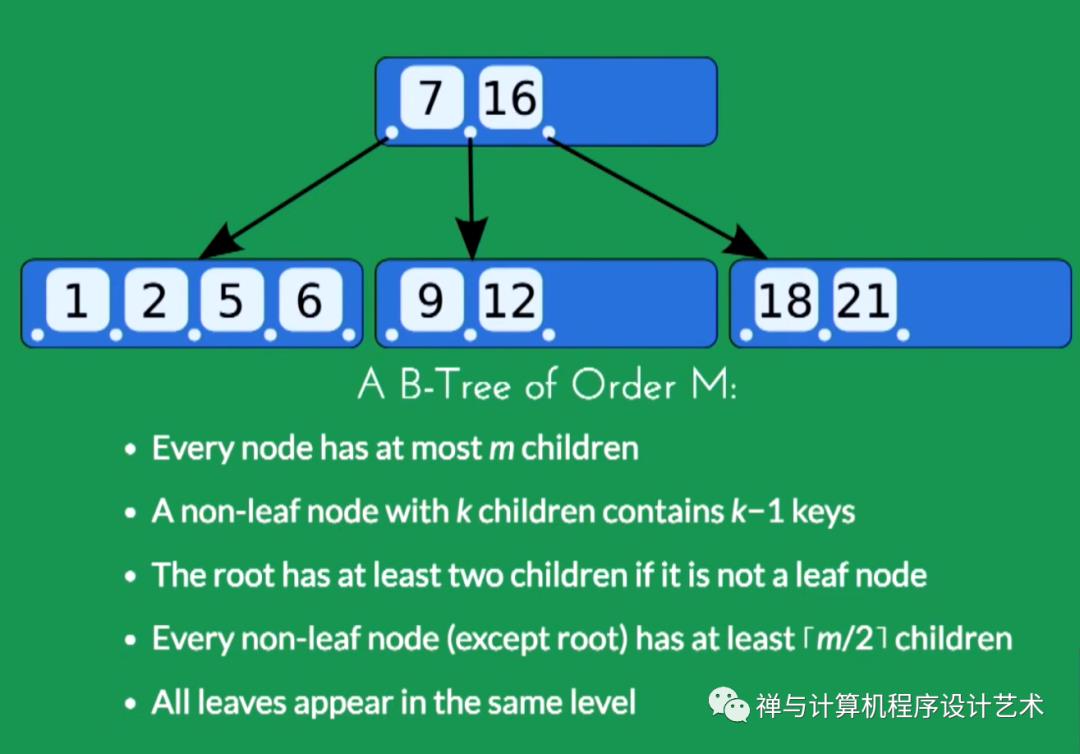
下图是一个 Order = 5 的 B Tree。
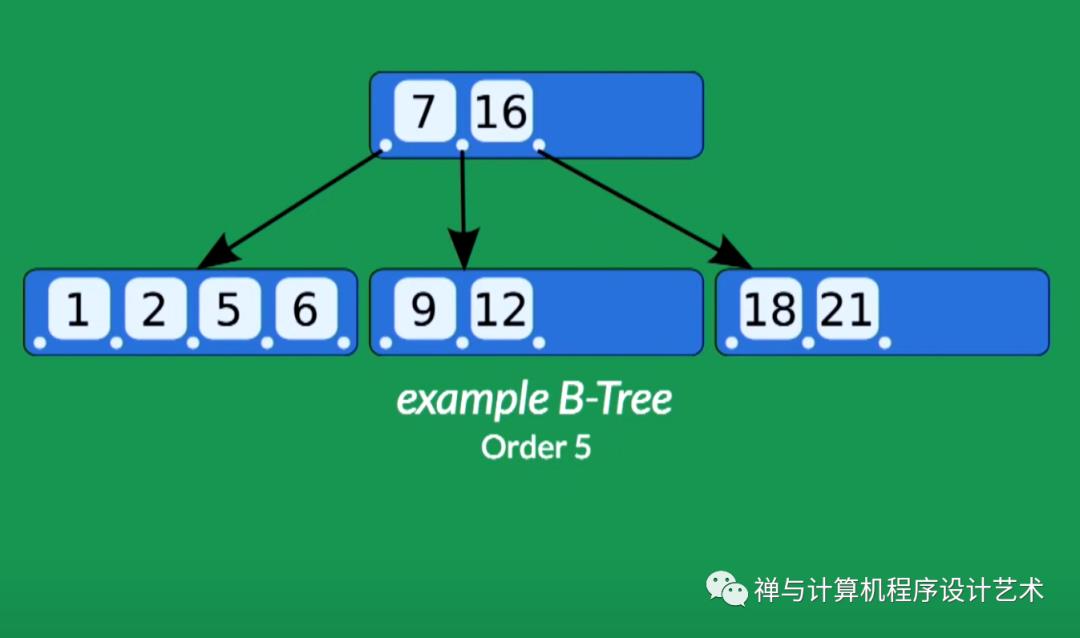
Origin
B-trees were invented by Rudolf Bayer and Edward M. McCreight while working at Boeing Research Labs, for the purpose of efficiently managing index pages for large random-access files. The basic assumption was that indices would be so voluminous that only small chunks of the tree could fit in main memory. Bayer and McCreight's paper, Organization and maintenance of large ordered indices,[1] was first circulated in July 1970 and later published in Acta Informatica.[3]
Bayer and McCreight never explained what, if anything, the B stands for: Boeing, balanced, broad, bushy, and Bayer have been suggested.[4][5][6] McCreight has said that "the more you think about what the B in B-trees means, the better you understand B-trees."[5]
Definition
According to Knuth's definition, a B-tree of order m is a tree which satisfies the following properties:[7]
Every node has at most m children.
Every internal node has at least ⌈m/2⌉ children.
Every non-leaf node has at least two children.
All leaves appear on the same level.
A non-leaf node with k children contains k−1 keys.
Each internal node's keys act as separation values which divide its subtrees.
为什么需要 B 树数据结构?
Why do you need a B-tree data strcuture?
随着访问硬盘等物理存储介质的时间越来越短,对 B 树的需求也随之增加。辅助存储设备速度较慢,容量较大。需要这种类型的数据结构来最大限度地减少磁盘访问。
其他数据结构如二叉搜索树、avl树、红黑树等只能在一个节点中存储一个键。如果你必须存储大量的键,那么这种树的高度就会变得非常大,访问时间也会增加。
但是,B-tree 可以在单个节点中存储许多键,并且可以有多个子节点。这显着降低了高度,允许更快的磁盘访问。
The need for B-tree arose with the rise in the need for lesser time in accessing the physical storage media like a hard disk. The secondary storage devices are slower with a larger capacity. There was a need for such types of data structures that minimize the disk accesses.
Other data structures such as a binary search tree, avl tree, red-black tree, etc can store only one key in one node. If you have to store a large number of keys, then the height of such trees becomes very large and the access time increases.
However, B-tree can store many keys in a single node and can have multiple child nodes. This decreases the height significantly allowing faster disk accesses.
B树应用
数据库和文件系统
存储数据块(辅助存储介质)
多级索引
B Tree Applications
databases and file systems
to store blocks of data (secondary storage media)
multilevel indexing
B树操作源代码
// Searching a key on a B-tree in Java
public class BTree
private int T;
// Node creation
public class Node
int n;
int key[] = new int[2 * T - 1];
Node child[] = new Node[2 * T];
boolean leaf = true;
public int Find(int k)
for (int i = 0; i < this.n; i++)
if (this.key[i] == k)
return i;
return -1;
;
public BTree(int t)
T = t;
root = new Node();
root.n = 0;
root.leaf = true;
private Node root;
// Search key
private Node Search(Node x, int key)
int i = 0;
if (x == null)
return x;
for (i = 0; i < x.n; i++)
if (key < x.key[i])
break;
if (key == x.key[i])
return x;
if (x.leaf)
return null;
else
return Search(x.child[i], key);
// Splitting the node
private void Split(Node x, int pos, Node y)
Node z = new Node();
z.leaf = y.leaf;
z.n = T - 1;
for (int j = 0; j < T - 1; j++)
z.key[j] = y.key[j + T];
if (!y.leaf)
for (int j = 0; j < T; j++)
z.child[j] = y.child[j + T];
y.n = T - 1;
for (int j = x.n; j >= pos + 1; j--)
x.child[j + 1] = x.child[j];
x.child[pos + 1] = z;
for (int j = x.n - 1; j >= pos; j--)
x.key[j + 1] = x.key[j];
x.key[pos] = y.key[T - 1];
x.n = x.n + 1;
// Inserting a value
public void Insert(final int key)
Node r = root;
if (r.n == 2 * T - 1)
Node s = new Node();
root = s;
s.leaf = false;
s.n = 0;
s.child[0] = r;
Split(s, 0, r);
insertValue(s, key);
else
insertValue(r, key);
// Insert the node
final private void insertValue(Node x, int k)
if (x.leaf)
int i = 0;
for (i = x.n - 1; i >= 0 && k < x.key[i]; i--)
x.key[i + 1] = x.key[i];
x.key[i + 1] = k;
x.n = x.n + 1;
else
int i = 0;
for (i = x.n - 1; i >= 0 && k < x.key[i]; i--)
;
i++;
Node tmp = x.child[i];
if (tmp.n == 2 * T - 1)
Split(x, i, tmp);
if (k > x.key[i])
i++;
insertValue(x.child[i], k);
public void Show()
Show(root);
// Display
private void Show(Node x)
assert (x == null);
for (int i = 0; i < x.n; i++)
System.out.print(x.key[i] + " ");
if (!x.leaf)
for (int i = 0; i < x.n + 1; i++)
Show(x.child[i]);
// Check if present
public boolean Contain(int k)
if (this.Search(root, k) != null)
return true;
else
return false;
public static void main(String[] args)
BTree b = new BTree(3);
b.Insert(8);
b.Insert(9);
b.Insert(10);
b.Insert(11);
b.Insert(15);
b.Insert(20);
b.Insert(17);
b.Show();
if (b.Contain(12))
System.out.println("\\nfound");
else
System.out.println("\\nnot found");
;
B+树
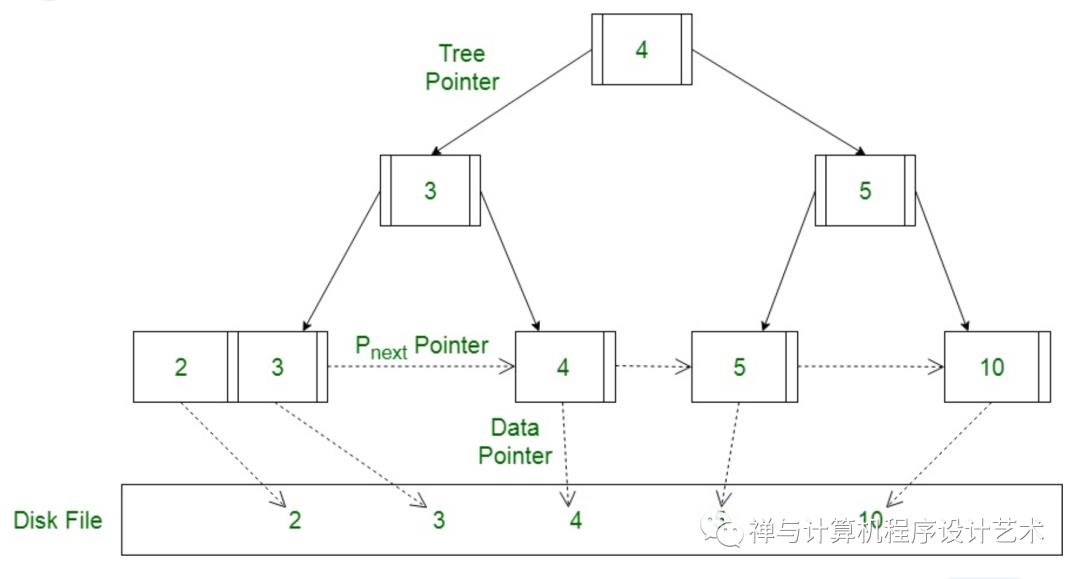
B+树是为磁盘和存储工具设计的一种数据结构,它是一种平衡查找树,它在查找,插入、修改方面的时间复杂度都稳定为 O(logn)。
节点
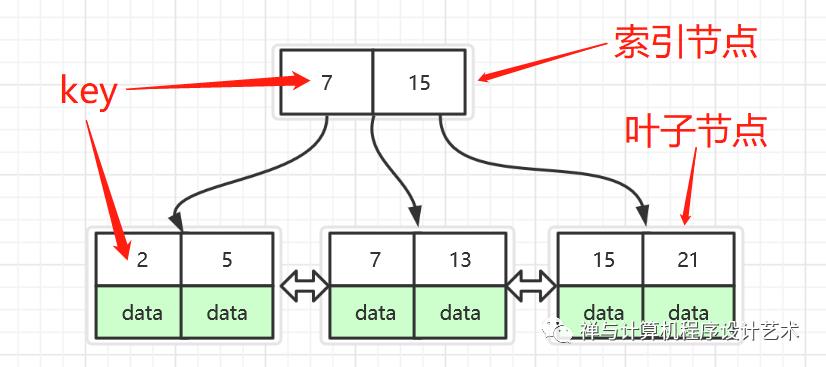
B+树节点是一组按照key有序的元素,B+树包含两种类型的节点,一种是索引节点,一种是叶子节点
索引节点也叫内部节点,索引节点只包含key,不包含data, 节点的 key是升序排列的,对于指定的索引节点key来说,它左子树上所有的key都小于它的key,它右子树上所有的key都大于等于它的key
叶节点上存储的是主键和数据(key和data), 所有的叶节点都在同一高度上,节点按key 从小到大并且通过指针使得彼此链接,这样,所有的叶节点组成了一个双向有序链表,叶节点这样做的好处是在不访问索引的情况下能顺序检索数据,也能很好的支持范围查询的快处理。
B+树特点
阶数为 m 的B+树,每个索引节点最多有 m 个子节点,每个索引节点页面最多存储 m - 1 个索引key
所有索引节点的子节点数在 Math.ceil(m / 2) 和 m 之间
B +树之所以称为平衡树,是因为从根节点到叶节点的每条路径都具有相同的长度。平衡树意味着所有对单个值的搜索都需要从磁盘读取相同数量的页面。
度数:在树中,每个节点的子节点(子树)的个数就称为该节点的度(degree)
阶数:(Order)阶定义为一个节点的子节点数目的最大值。(自带最大值属性)
填充因子
B+树使用填充因子来控制页面的分裂和合并,设置数据占用页面空间的百分比,目的是为后面的数据预留一部分页空间,当有新数据时,可以放到预留的页空间中,避免分页的发生。默认的填充因子是50%,对于一棵m阶的B+树,填充因子是 m/2。
B+树是常用于数据库和操作系统的文件系统中的一种用于查找的数据结构。
m阶B+树与m阶的B树的主要差异在于:
(1)在B+树中,具有n个关键字的结点只含有n棵子树,即每个关键字对应一棵子树;而在B树中,具有n个结点的关键字含有(n+1)棵子树。
(2)在B+树中,每个结点(非根内部结点)关键字个数n的范围是ceil(m/2)<=n<=m(根节点1<=n<=m),在B树中,每个结点(非根内部结点)关键字个数n的范围是ceil(m/2)-1<=n<=m-1(根节点:1<=n<=m-1)。
(3)在B+树中,叶结点包含信息,所有非叶结点仅起到索引作用,非叶结点中的每个索引项只含有对应子树的最大关键字和指向该子树的指针,不含有该关键字对应记录的存储地址。
(4)在B+树中,叶结点包含了全部关键字,即在非叶结点中出现的关键字也会出现在叶节点中;而在B树中,叶结点包含的关键字和其他节点包含的关键字是不重复的。
(5)在B+树中,有一个指针指向关键字最小的叶子结点,所有叶子结点连接成一个链表。
Let’s see the difference between B-tree and B+ tree:
| Basis of Comparision | B tree | B+ tree |
|---|---|---|
| Pointers | All internal and leaf nodes have data pointers | Only leaf nodes have data pointers |
| Search | Since all keys are not available at leaf, search often takes more time. | All keys are at leaf nodes, hence search is faster and more accurate. |
| Redundant Keys | No duplicate of keys is maintained in the tree. | Duplicate of keys are maintained and all nodes are present at the leaf. |
| Insertion | Insertion takes more time and it is not predictable sometimes. | Insertion is easier and the results are always the same. |
| Deletion | Deletion of the internal node is very complex and the tree has to undergo a lot of transformations. | Deletion of any node is easy because all node are found at leaf. |
| Leaf Nodes | Leaf nodes are not stored as structural linked list. | Leaf nodes are stored as structural linked list. |
| Access | Sequential access to nodes is not possible | Sequential access is possible just like linked list |
| Height | For a particular number nodes height is larger | Height is lesser than B tree for the same number of nodes |
| Application | B-Trees used in Databases, Search engines | B+ Trees used in Multilevel Indexing, Database indexing |
| Number of Nodes | Number of nodes at any intermediary level ‘l’ is 2l. | Each intermediary node can have n/2 to n children. |
B+树的缺点:
B 树的主要缺点是难以按顺序遍历键。B+树保留了B树的快速随机访问特性,同时也允许快速顺序访问。
B+树的应用:
多级索引
树上更快的操作(插入、删除、搜索)
数据库索引
BST:binary search tree,二叉搜索树
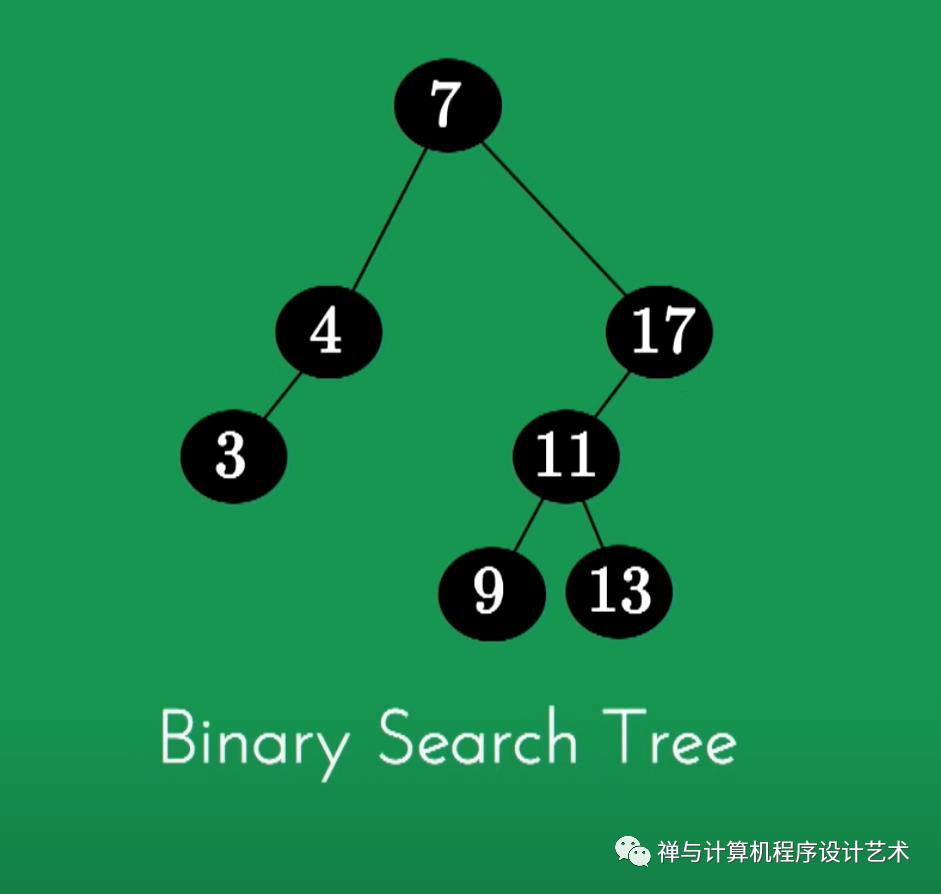
二叉搜索树是一种数据结构,可以让我们快速维护一个排序的数字列表。
之所以称为二叉树,是因为每个树节点最多有两个子节点。
它被称为搜索树,因为它可以用来及时搜索一个数字的存在O(log(n))。
将二叉搜索树与常规二叉树分开的属性是:
左子树的所有节点都小于根节点
右子树的所有节点都大于根节点
每个节点的两个子树也是 BST,即它们具有以上两个属性。
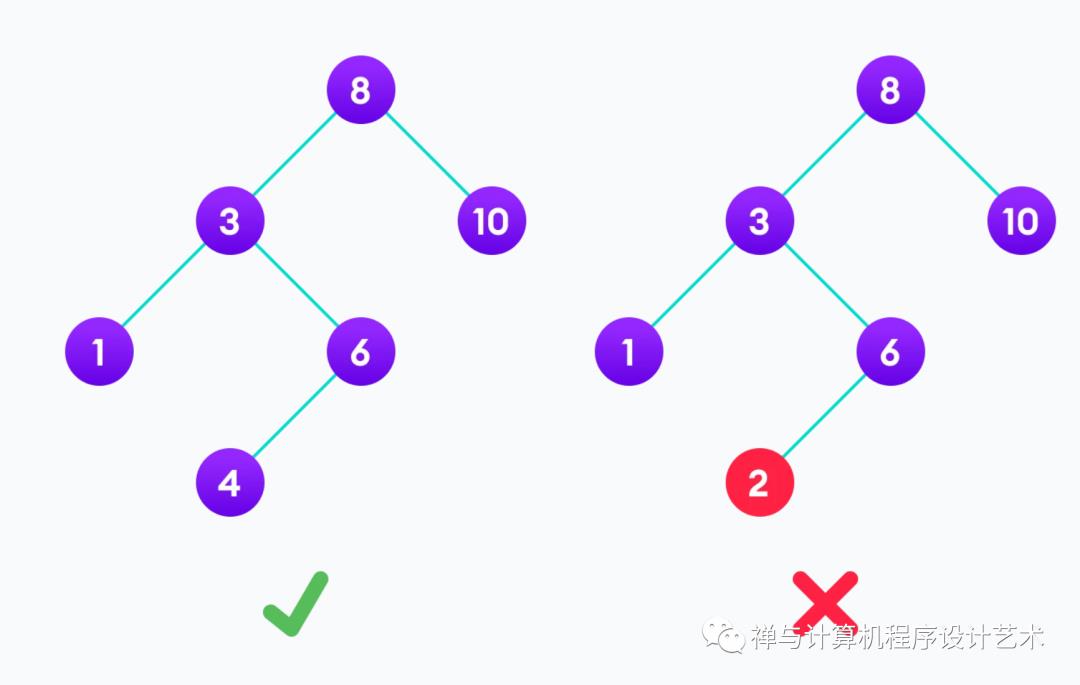
上图中,右子树的一个值小于根的树表明它不是有效的二叉搜索树。
二叉搜索树应用
在数据库的多级索引中
用于动态排序
用于管理 Unix 内核中的虚拟内存区域
Binary Search Tree Applications
In multilevel indexing in the database
For dynamic sorting
For managing virtual memory areas in Unix kernel
Binary Search Tree operations in C
// Binary Search Tree operations in C
#include <stdio.h>
#include <stdlib.h>
struct node
int key;
struct node *left, *right;
;
// Create a node
struct node *newNode(int item)
struct node *temp = (struct node *)malloc(sizeof(struct node));
temp->key = item;
temp->left = temp->right = NULL;
return temp;
// Inorder Traversal
void inorder(struct node *root)
if (root != NULL)
// Traverse left
inorder(root->left);
// Traverse root
printf("%d -> ", root->key);
// Traverse right
inorder(root->right);
// Insert a node
struct node *insert(struct node *node, int key)
// Return a new node if the tree is empty
if (node == NULL) return newNode(key);
// Traverse to the right place and insert the node
if (key < node->key)
node->left = insert(node->left, key);
else
node->right = insert(node->right, key);
return node;
// Find the inorder successor
struct node *minValueNode(struct node *node)
struct node *current = node;
// Find the leftmost leaf
while (current && current->left != NULL)
current = current->left;
return current;
// Deleting a node
struct node *deleteNode(struct node *root, int key)
// Return if the tree is empty
if (root == NULL) return root;
// Find the node to be deleted
if (key < root->key)
root->left = deleteNode(root->left, key);
else if (key > root->key)
root->right = deleteNode(root->right, key);
else
// If the node is with only one child or no child
if (root->left == NULL)
struct node *temp = root->right;
free(root);
return temp;
else if (root->right == NULL)
struct node *temp = root->left;
free(root);
return temp;
// If the node has two children
struct node *temp = minValueNode(root->right);
// Place the inorder successor in position of the node to be deleted
root->key = temp->key;
// Delete the inorder successor
root->right = deleteNode(root->right, temp->key);
return root;
// Driver code
int main()
struct node *root = NULL;
root = insert(root, 8);
root = insert(root, 3);
root = insert(root, 1);
root = insert(root, 6);
root = insert(root, 7);
root = insert(root, 10);
root = insert(root, 14);
root = insert(root, 4);
printf("Inorder traversal: ");
inorder(root);
printf("\\nAfter deleting 10\\n");
root = deleteNode(root, 10);
printf("Inorder traversal: ");
inorder(root);
红黑树
红黑树是二叉搜索树的一种。它像AVL 树一样是自平衡的,尽管它使用不同的属性来保持平衡的不变性。平衡二叉搜索树的搜索效率比不平衡二叉搜索树高得多,因此维持平衡所需的复杂性通常是值得的。它们被称为红黑树,因为树中的每个节点都被标记为红色或黑色。
In computer science, a red–black tree is a kind of self-balancing binary search tree. Each node stores an extra bit representing "color" ("red" or "black"), used to ensure that the tree remains balanced during insertions and deletions.
红黑树比 AVL 树保持稍微宽松的高度不变性。因为红黑树的高度稍大,在红黑树中查找会比较慢。然而,更宽松的高度不变性使得插入和删除更快。此外,由于相对容易实现,红黑树很受欢迎。
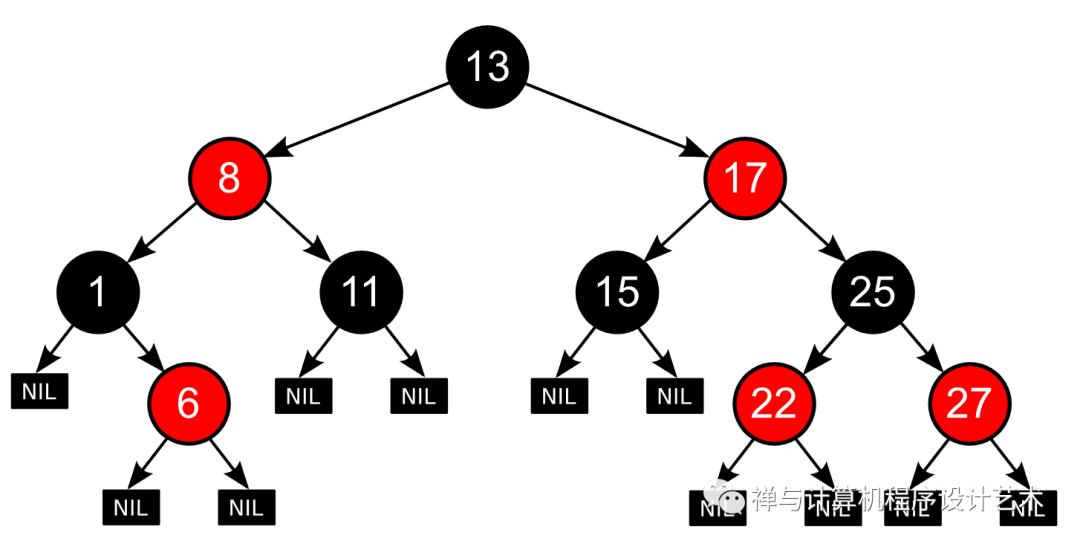
此图像显示了红黑树的表示。请注意每片叶子实际上是一个黑色的空值。这些属性对于证明树的高度不变性很重要。
概述
红黑树类似于二叉搜索树,它由节点组成,每个节点最多有两个孩子。但是,有一些特定于红黑树的新属性。
红黑树是在1972年由Rudolf Bayer发明的,当时被称为平衡二叉B树(symmetric binary B-trees)。后来,在1978年被 Leo J. Guibas 和 Robert Sedgewick 修改为如今的“红黑树”。
红黑树是一种特化的AVL树(平衡二叉树),都是在进行插入和删除操作时通过特定操作保持二叉查找树的平衡,从而获得较高的查找性能。
红黑树是每个结点都带有颜色属性的二叉查找树,颜色或红色或黑色。 [3] 在二叉查找树强制一般要求以外,对于任何有效的红黑树我们增加了如下的额外要求:
性质1. 结点是红色或黑色。
性质2. 根结点是黑色。
性质3. 所有叶子都是黑色。(叶子是NIL结点)
性质4. 每个红色结点的两个子结点都是黑色。(从每个叶子到根的所有路径上不能有两个连续的红色结点)
性质5. 从任一结点到其每个叶子的所有路径都包含相同数目的黑色结点。
这些约束强制了红黑树的关键性质: 从根到叶子的最长的可能路径不多于最短的可能路径的两倍长。结果是这个树大致上是平衡的。
因为操作比如插入、删除和查找某个值的最坏情况时间都要求与树的高度成比例,这个在高度上的理论上限允许红黑树在最坏情况下都是高效的,而不同于普通的二叉查找树。
性质4保证了路径上不能有两个连续的红色结点。最短的可能路径都是黑色结点,最长的可能路径有交替的红色和黑色结点。因为根据性质5所有最长的路径都有相同数目的黑色结点,这就表明了没有路径能多于任何其他路径的两倍长。
因为红黑树是一种特化的二叉查找树,所以红黑树上的只读操作与普通二叉查找树相同。
红黑树的数据结构模型
// Basic type definitions:
enum color_t BLACK, RED ;
struct RBnode // node of red–black tree
RBnode* parent; // == NULL if root of the tree
RBnode* child[2]; // == NIL if child is empty
// Index is:
// LEFT := 0, if (key < parent->key)
// RIGHT := 1, if (key > parent->key)
enum color_t color;
int key;
;
#define NIL NULL // null pointer or pointer to sentinel node
#define LEFT 0
#define RIGHT 1
#define left child[LEFT]
#define right child[RIGHT]
struct RBtree // red–black tree
RBnode* root; // == NIL if tree is empty
;
// Get the child direction (∈ LEFT, RIGHT )
// of the non-root non-NIL RBnode* N:
#define childDir(N) ( N == (N->parent)->right ? RIGHT : LEFT )References
Bayer, R.; McCreight, E. (July 1970). "Organization and maintenance of large ordered indices" (PDF). Proceedings of the 1970 ACM SIGFIDET (Now SIGMOD) Workshop on Data Description, Access and Control - SIGFIDET '70. Boeing Scientific Research Laboratories. p. 107. doi:10.1145/1734663.1734671. S2CID 26930249.
Comer 1979.
Bayer & McCreight 1972.
Comer 1979, p. 123 footnote 1.
Weiner, Peter G. (30 August 2013). "4- Edward M McCreight" – via Vimeo.
"Stanford Center for Professional Development". scpd.stanford.edu. Archived from the original on 2014-06-04. Retrieved 2011-01-16.
Knuth 1998, p. 483.
Folk & Zoellick 1992, p. 362.
Folk & Zoellick 1992.
Folk & Zoellick 1992, p. 363.
Bayer & McCreight (1972) avoided the issue by saying an index element is a (physically adjacent) pair of (x, a) where x is the key, and a is some associated information. The associated information might be a pointer to a record or records in a random access, but what it was didn't really matter. Bayer & McCreight (1972) states, "For this paper the associated information is of no further interest."
Folk & Zoellick 1992, p. 379.
Knuth 1998, p. 488.
Tomašević, Milo (2008). Algorithms and Data Structures. Belgrade, Serbia: Akademska misao. pp. 274–275. ISBN 978-86-7466-328-8.
Rigin A. M., Shershakov S. A. (2019-09-10). "SQLite RDBMS Extension for Data Indexing Using B-tree Modifications". Proceedings of the Institute for System Programming of the RAS. Institute for System Programming of the RAS (ISP RAS). 31 (3): 203–216. doi:10.15514/ispras-2019-31(3)-16. S2CID 203144646. Retrieved 2021-08-29.
Counted B-Trees, retrieved 2010-01-25
Seagate Technology LLC, Product Manual: Barracuda ES.2 Serial ATA, Rev. F., publication 100468393, 2008 [1], page 6
Kleppmann, Martin (2017), Designing Data-Intensive Applications, Sebastopol, California: O'Reilly Media, p. 80, ISBN 978-1-449-37332-0
Jan Jannink. "Implementing Deletion in B+-Trees". Section "4 Lazy Deletion".
Comer 1979, p. 127; Cormen et al. 2001, pp. 439–440
"Deletion in a B-tree" (PDF). cs.rhodes.edu. Archived (PDF) from the original on 2022-10-09. Retrieved 24 May 2022.
"Cache Oblivious B-trees". State University of New York (SUNY) at Stony Brook. Retrieved 2011-01-17.
Mark Russinovich. "Inside Win2K NTFS, Part 1". Microsoft Developer Network. Archived from the original on 13 April 2008. Retrieved 2008-04-18.
Matthew Dillon (2008-06-21). "The HAMMER Filesystem" (PDF). Archived (PDF) from the original on 2022-10-09.
Lehman, Philip L.; Yao, s. Bing (1981). "Efficient locking for concurrent operations on B-trees". ACM Transactions on Database Systems. 6 (4): 650–670. doi:10.1145/319628.319663. S2CID 10756181.
Wang, Paul (1 February 1991). "An In-Depth Analysis of Concurrent B-tree Algorithms" (PDF). dtic.mil. Archived from the original (PDF) on 4 June 2011. Retrieved 21 October 2022.
"Downloads - high-concurrency-btree - High Concurrency B-Tree code in C - GitHub Project Hosting". GitHub. Retrieved 2014-01-27.
"Lockless concurrent B-tree index meta access method for cached nodes".
General
Bayer, R.; McCreight, E. (1972), "Organization and Maintenance of Large Ordered Indexes" (PDF), Acta Informatica, 1 (3): 173–189, doi:10.1007/bf00288683, S2CID 29859053
Comer, Douglas (June 1979), "The Ubiquitous B-Tree", Computing Surveys, 11 (2): 123–137, doi:10.1145/356770.356776, ISSN 0360-0300, S2CID 101673.
Cormen, Thomas; Leiserson, Charles; Rivest, Ronald; Stein, Clifford (2001), Introduction to Algorithms (Second ed.), MIT Press and McGraw-Hill, pp. 434–454, ISBN 0-262-03293-7. Chapter 18: B-Trees.
Folk, Michael J.; Zoellick, Bill (1992), File Structures (2nd ed.), Addison-Wesley, ISBN 0-201-55713-4
Knuth, Donald (1998), Sorting and Searching, The Art of Computer Programming, vol. 3 (Second ed.), Addison-Wesley, ISBN 0-201-89685-0. Section 6.2.4: Multiway Trees, pp. 481–491. Also, pp. 476–477 of section 6.2.3 (Balanced Trees) discusses 2–3 trees.
Original papers
Bayer, Rudolf; McCreight, E. (July 1970), Organization and Maintenance of Large Ordered Indices, vol. Mathematical and Information Sciences Report No. 20, Boeing Scientific Research Laboratories.
Bayer, Rudolf (1971), Binary B-Trees for Virtual Memory, Proceedings of 1971 ACM-SIGFIDET Workshop on Data Description, Access and Control, San Diego, California.
https://www.programiz.com/dsa/binary-search-tree
https://brilliant.org/wiki/red-black-tree/
https://en.wikipedia.org/wiki/Red%E2%80%93black_tree
【更多阅读】
《人月神话》8 胸有成竹(Chaptor 8.Calling the Shot -The Mythical Man-Month)
《人月神话》(The Mythical Man-Month)5画蛇添足(The Second-System Effect)
《人月神话》(The Mythical Man-Month)4概念一致性:专制、民主和系统设计(System Design)
《人月神话》(The Mythical Man-Month)1 看清问题的本质:如果我们想解决问题,就必须试图先去理解它
Redis 作者 Antirez 讲如何实现分布式锁?Redis 实现分布式锁天然的缺陷分析&Redis分布式锁的正确使用姿势!
十年技术进阶路:让我明白了三件要事。关于如何做好技术 Team Leader?如何提升管理业务技术水平?(10000字长文)
以上是关于B-树(B-Tree)与二叉搜索树(BST):讲讲数据库和文件系统背后的原理(读写比较大块数据的存储系统数据结构与算法原理)...的主要内容,如果未能解决你的问题,请参考以下文章
B-树(B-Tree)与二叉搜索树(BST):讲讲数据库和文件系统背后的原理(读写比较大块数据的存储系统数据结构与算法原理)...
B-树(B-Tree)与二叉搜索树(BST):讲讲数据库和文件系统背后的原理(读写比较大块数据的存储系统数据结构与算法原理)...
B-树(B-Tree)与二叉搜索树(BST):讲讲数据库和文件系统背后的原理(读写比较大块数据的存储系统数据结构与算法原理)...
B-树(B-Tree)与二叉搜索树(BST):讲讲数据库和文件系统背后的原理(读写比较大块数据的存储系统数据结构与算法原理)...
B-树(B-Tree)与二叉搜索树(BST):讲讲数据库和文件系统背后的原理(读写比较大块数据的存储系统数据结构与算法原理)...